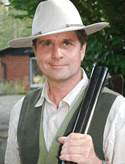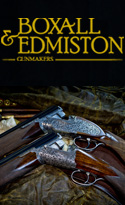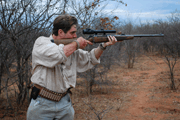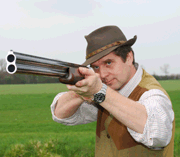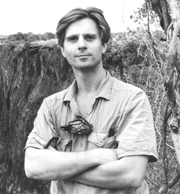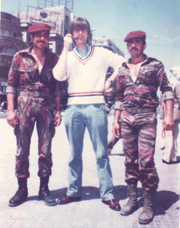Shooting Technique - Balance, Power and Tension
Over the years, I have spent many hundreds of hours, perhaps thousands, considering shooting technique. I have experimented in the field, taken tens of thousands of photographs of people shooting, and shot much film. I have had numerous discussions on technique with fellow instructors, international and domestic competitors, and not least, many ordinary shooters. I have also read just about everything that has been written on the subject of shooting and have a library, which includes 2000+ volumes and monographs on the broad subject and incorporates the library of my late and much missed friend and mentor, Chris Cradock. In short, for the last 40 plus years, this has been a great part of life and partly defines who I am.
I remain curious about all things shooting, but, through this experience I am also acutely aware that books, articles, films and such like, often do not get the fully story across when it comes to technique. They can give insight, but they can no more teach you to shoot, than a book on surgery will turn you into a surgeon. I think, nevertheless, it is worth defining and exploring the act of shooting as well and as clearly and accurately as possible. In the future, I can also imagine the development of more computer applications – a few exist already – that will help us with technique (much as these have been developed for golf and tennis). Like any subject this is one which grows.
Now this brings me in rather meandering but not entirely irrelevant fashion to the main topics 'balance, power and tension'. The last two words are not heard that much in the context of shooting technique (though perhaps occasionally). Normally we are describing things like stance, gun-mount, swing, forward allowance, gunfit, and shooting vision. All these are important, but in my instruction in recent years, I have also noted that many people misunderstand the concepts just mentioned, though they are vitally important (as important as any of the others). Let us take them one by one as part of our journey in considering how we shoot and how we might improve it.
Balance
This is perhaps the easiest of the three to conceive (and the one which is discussed the most). It is my observation that to shoot well, you must be in balance – especially at the moment is trigger is pulled. Your stance must be a good, balanced, one to achieve this. So must your hold, your ready position and so on. Your equipment must promote as well as feeling 'right' aiding you in executing your developed technique well. I think, meantime, that it is immediately obvious when you watch someone shoot to see whether they are in balance or not. In a similar way, a well balanced gun is recognisable when shot (but not necessarily from 'dry' handling alone).
Some will seem almost to be falling over when they fire, some leaning back with head off stock, some leaning too far forward, some with feet that are spaced far too wide and shoulders poorly angled as if they were rifle shooting (and needed no swing), some will transfer the weight from left to right foot unintentionally as they swing, some will just look wrong though you may not be able to define precisely why at first glance – something is out of place.
The concept of balance is a holistic one. Let's revert to KISS (Keep it Simple Stupid) now. If you want to be in balance at the moment you pull the trigger, you must have developed a good stance and gun hold (the front hand should not be too far forward or back), and you must position your body with consideration of where you want to break the target. Balance implies economy of effort and good preparation. I usually choose to stand towards the break-point, which I find promotes balance at the moment of the shot. It may, however, lead to some tension in the ready position – so, balance may also involve something of a compromise. We need to consider balance through out the swing. Some will prefer to point their front foot to the break point, rather, than have their rear foot at 90 degrees to it as I usually do.
Tension
This brings us on quite neatly to tension. Generally speaking, tension is the enemy of good shooting, but there are qualifications again. In my ready position, I wind back toward the trap, stopping the gun where I first see the target clearly as a solid object. I bring my eyes, turning the head slightly, back to the zone where I first see the target as a blurr on its flight line. This implies some tension, because I am a spring waiting to uncoil into the target (by means of good upper body rotation). I achieve the power for the swing – jumping ahead momentarily to our next subject – from this slightly coiled up position. So, there is some tension at the beginning of the ready, but little as the trigger is pulled. My stock fit allows me to keep my head on the stock with minimum effort, and grip and forend promote effortless purchase and good, natural, pointing.
As for the rest of the body, I try and reduce tension as much as possible. My back is straight and relaxed. My shoulders are relaxed too. There is some tension in my front forward leg (which I prefer to keep straight usually and as relaxed as possible) and my front arm which both lifts and controls the gun. When I look at people shooting, I am always trying to spot excessive tension. I make the client aware of it, and try and get them to reduce it noting that when sporting shooting the only tension that one might be aware of relates to the front arm. Some people are horribly tense when they shoot and I may get them to perform simple exercises like relaxing though the back, rolling the shoulders or alternative nostril breathing in really bad cases.
Power
Now we come to power, an interesting concept. What I am getting at here is how you should power your gun as you swing it to and beyond the bird. The classic error is to use the hands too much and the body insufficiently. Rushing is also a major sin. We have talked of upper body rotation. On a standard crossing bird, this is tank turret like movement level with the flight line. The body, and particularly the upper body is the engine of the swing, as discussed, but the arms do play a role in follow through and fine muzzle control. Because one may generate power with the body, there is no need to rush, smooth power and control from good, unrushed, body movement. In this context I often talk of being 'with the bird' – the idea that one is not rushing in front of it (which often leads to a rush to a stop) but moving to and through it in a relaxed, elegant, and powerfully efficient manner. For an incoming overhead bird the engine of the swing is the body, but instead of a rotational movement it is a controlled arching most obvious in the mid-back – though it goes all through the body. Again there is no need to rush if one uses the body well.
So, there you have it – balance, tension and power. Next time you shoot, consider your own shooting with these words in mind. Watch others too, it is all about becoming more aware. Once you have that awareness you can adapt technique and develop the muscle memory, I would prefer to call it body and mind memory.


